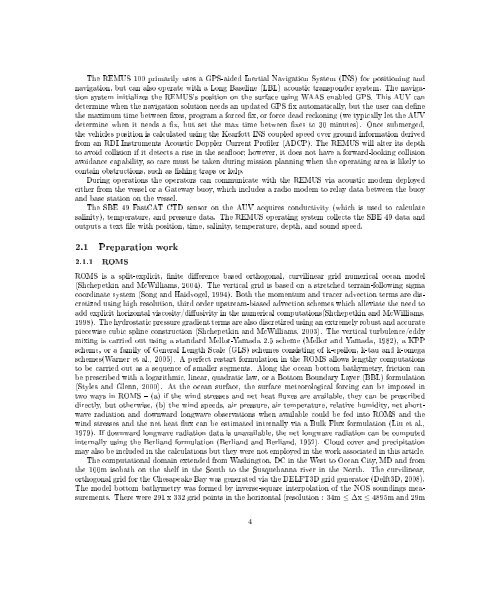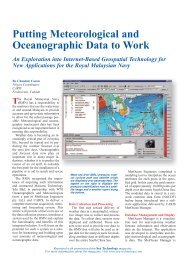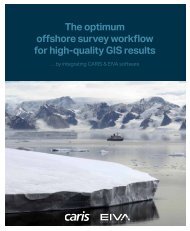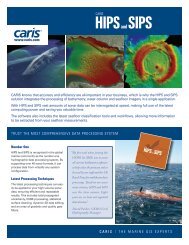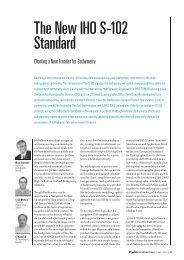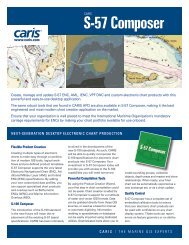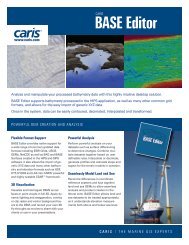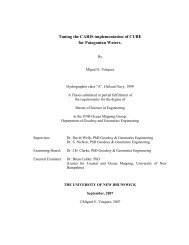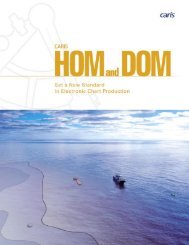Create successful ePaper yourself
Turn your PDF publications into a flip-book with our unique Google optimized e-Paper software.
The REMUS 100 primarily uses a GPS-aided Inertial Navigation System (INS) for positioning andnavigation, but can also operate with a Long Baseline (LBL) acoustic transponder system. The navigationsystem initializes the REMUS's position on the surface using WAAS enabled GPS. This AUV candetermine when the navigation solution needs an updated GPS x automatically, but the user can denethe maximum time between xes, program a forced x, or force dead reckoning (we typically let the AUVdetermine when it needs a x, but set the max time between xes to 30 minutes). Once submerged,the vehicles position is calculated using the Kearfott INS coupled speed over ground information derivedfrom an RDI Instruments Acoustic Doppler Current Proler (ADCP). The REMUS will alter its depthto avoid collision if it detects a rise in the seaoor; however, it does not have a forward-looking collisionavoidance capability, so care must be taken during mission planning when the operating area is likely tocontain obstructions, such as shing traps or kelp.During operations the operators can communicate with the REMUS via acoustic modem deployedeither from the vessel or a Gateway buoy, which includes a radio modem to relay data between the buoyand base station on the vessel.The SBE 49 FastCAT CTD sensor on the AUV acquires conductivity (which is used to calculatesalinity), temperature, and pressure data. The REMUS operating system collects the SBE 49 data andoutputs a text le with position, time, salinity, temperature, depth, and sound speed.2.1 Preparation work2.1.1 ROMSROMS is a split-explicit, nite dierence based orthogonal, curvilinear grid numerical ocean model(Shchepetkin and McWilliams, 2004). The vertical grid is based on a stretched terrain-following sigmacoordinate system (Song and Haidvogel, 1994). Both the momentum and tracer advection terms are discretizedusing high resolution, third order upstream-biased advection schemes which alleviate the need toadd explicit horizontal viscosity/diusivity in the numerical computations(Shchepetkin and McWilliams,1998). The hydrostatic pressure gradient terms are also discretized using an extremely robust and accuratepiecewise cubic spline construction (Shchepetkin and McWilliams, 2003). The vertical turbulence/eddymixing is carried out using a standard Mellor-Yamada 2.5 scheme (Mellor and Yamada, 1982), a KPPscheme, or a family of General Length Scale (GLS) schemes consisting of k-epsilon, k-tau and k-omegaschemes(Warner et al., 2005). A perfect restart formulation in the ROMS allows lengthy computationsto be carried out as a sequence of smaller segments. Along the ocean bottom bathymetry, friction canbe prescribed with a logarithmic, linear, quadratic law, or a Bottom Boundary Layer (BBL) formulation(Styles and Glenn, 2000). At the ocean surface, the surface meteorological forcing can be imposed intwo ways in ROMS (a) if the wind stresses and net heat uxes are available, they can be prescribeddirectly, but otherwise, (b) the wind speeds, air pressure, air temperature, relative humidity, net shortwaveradiation and downward longwave observations when available could be fed into ROMS and thewind stresses and the net heat ux can be estimated internally via a Bulk Flux formulation (Liu et al.,1979). If downward longwave radiation data is unavailable, the net longwave radiation can be computedinternally using the Berliand formulation (Berliand and Berliand, 1952). Cloud cover and precipitationmay also be included in the calculations but they were not employed in the work associated in this article.The computational domain extended from Washington, DC in the West to Ocean City, MD and fromthe 100m isobath on the shelf in the South to the Susquehanna river in the North. The curvilinear,orthogonal grid for the Chesapeake Bay was generated via the DELFT3D grid generator (Delft3D, 2008).The model bottom bathymetry was formed by inverse-square interpolation of the NOS soundings measurements.There were 291 x 332 grid points in the horizontal (resolution : 34m ≤ Δx ≤ 4895m and 29m4


